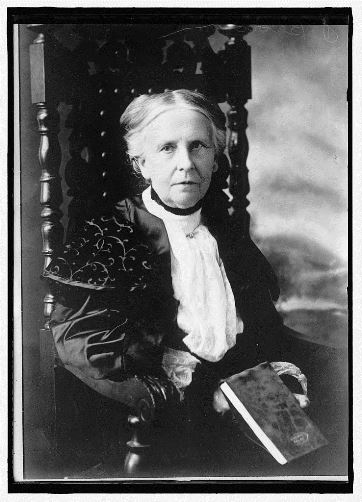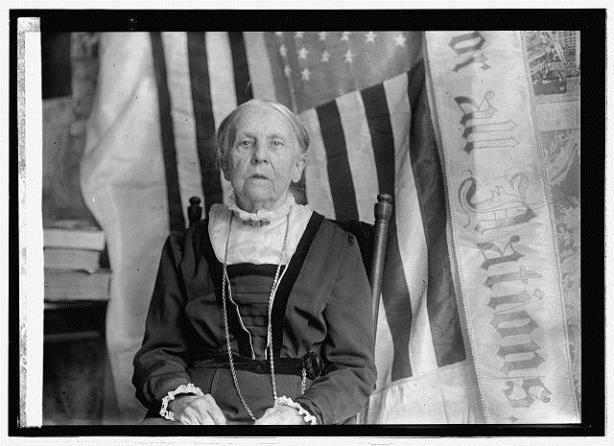By Andy Piascik
When the board of Bridgeport’s First Universalist Church offered Olympia Brown a position as minister in 1869, not everyone in the church’s congregation approved. Congregants protested, and the protests grew when Brown arrived in Bridgeport for a trial sermon at the church. Not one to shy away from a challenge, Brown met with those who objected to her hiring and asked that they listen to her sermon before arriving at judgement. After hearing her, an overwhelmingly majority of the congregation decided to hire Brown.
Born in Michigan in 1835, Olympia Brown attended Mount Holyoke Female Seminary in Massachusetts, transferred to Antioch College in Ohio, and graduated in 1860. Desiring a life as a minister, Brown received numerous rejections from seminary schools (because she was a woman) before St. Lawrence University’s Theological School in New York accepted her. Brown persevered in the face of continuous hostility and, in 1863, became the first woman in the history of the United States to be ordained a minister by full denominational authority. (Antoinette Brown, ordained ten years earlier by the Congregational church in South Butler, New York, was only ordained by a single congregation).
Olympia Brown worked one year in Vermont and five years at the Universalist church in Weymouth Landing, Massachusetts. She contributed greatly to a vibrant, intellectual atmosphere there by regularly inviting prominent area residents like Ralph Waldo Emerson and David Lloyd Garrison, who shared her sympathies for the abolitionist and suffrage movements, to lecture at the church.
The First American Woman Ordained a Minister Comes to the Park City

Mrs. Olympia Brown, ca. 1919- Library of Congress, Prints and Photographs Division, Harris & Ewing Collection
Though most of Bridgeport’s Universalist community welcomed Brown, a small, vocal minority led by long-time congregant James Staples opposed having their church led by a woman. Though Brown’s opponents never grew beyond their original small numbers, they did erode church morale. The congregation diminished in size and the church’s financial situation, always problematic, worsened.
Brown remained determined, however, and she declined an offer of a higher-paying position in Pennsylvania in 1873 to remain in Bridgeport. That year she also married John Henry Willis, who moved to Bridgeport from Weymouth Landing to woo her. She gave birth to a son the following year.
In addition to personal happiness, Brown also passionately immersed herself in the cause of women’s equality during her years in Bridgeport. She worked with Susan B. Anthony, Lucy Stone, Elizabeth Cady Stanton, and other leading figures of the suffrage movement, and traveled to Hartford and Washington to testify before various legislative committees. She actively spread the suffrage word in Bridgeport through petition drives and other efforts.
For James Staples and his allies, Brown’s activism only compounded their hostility to her service as their church’s minister. In 1874, they expanded their efforts beyond the First Universalist congregation with meetings around Bridgeport. They also called on local ministers to speak out against women ministers generally and Brown in particular.
Olympia Brown Leaves Bridgeport
In early 1876, the tensions within the First Universalist congregation and Bridgeport’s larger religious community reached a breaking point. Though still a small minority, James and his group successfully lobbied to get an injunction placed on the church. The board of trustees, which like the congregation still supported Brown, announced that they could no longer afford to employ a minister, and Brown’s term at the church ended in March.
The success of the opposition group was as big a blow as Brown had yet endured, but she moved on without missing a beat. She remained active in organizations such as the National Woman Suffrage Association and continued traveling, lecturing, and testifying on behalf of the cause she held so dear. Brown gave birth to a daughter in 1876 and remained in Bridgeport with her husband and children for nearly three years after leaving the Universalist Church. She finally accepted a ministry position in Wisconsin at the end of 1878.
Brown was still participating in suffrage activities in 1920 when legislators ratified the 19th Amendment to the Constitution. A member of Alice Paul’s National Woman’s Party, she and women around the country voted for the first time that November. Olympia Brown died six years later, on October 23, 1926, in Baltimore, at the age of 91.
Bridgeport native Andy Piascik is an award-winning author who has written for many publications and websites over the last four decades. He is also the author of two books.









